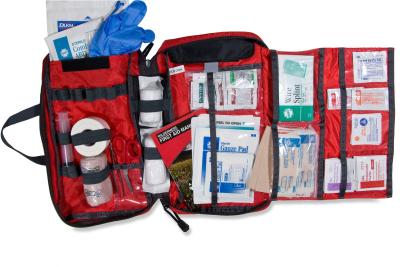
First Aid Kit Checklist
A well stocked first kid kit can benefit you and your family during a disaster or emergency. Emergency physicians recommend that every home be prepared to respond to common medical emergencies by having a first aid kit. Prevention is the best way to keep you and your family safe, but if an accident occurs your home first aid kit should be a first response item. The first aid kit should be tailored to meet your needs. Your physician can provide you with specific advice for any existing medical conditions you or your family may have, and assist you with planning for those supplemental items you may require. Consult your physician or pharmacist about any issues related to medication storage and use.
It doesn't matter if your first aid kit is homemade or a commercial product, as long as you feel that it will meet your needs. Many find a tote bag is ideal for holding the First Aid contents. Besides being easy to transport, it is visible where it is kept. Besides having a First Aid Kit, it is important that several family members should know where it is and how to use the items that it contains. For added preparation, inquire in your community about first aid and CPR training to supplement your kit.
Plan your kit well, and inventory it's contents every six months to ensure that no items have expired.
If your kit contains medications, remember to follow the recommendations by your physician. Store medications out of reach of children, and use products with child safety caps. Check your kit often for expiration dates, and replace items as needed or recommended by your physician.
If someone in your household has a life-threatening allergy, carry appropriate medication with you at all times.
Training and Preparation
First Aid Manual: A valuable resource when responding to emergencies at home.
First Aid and CPR course: Local agencies such as the American Red Cross provide training courses for these important topics.
Emergency Phone Numbers: Family Physician,regional Poison Control Center, and if your area is not served by 911 the numbers for local police, fire and ambulance services.
List of Allergies: a separate list for each household member.
List of Medications: a separate list for each household member.
List of Existing Medical Conditions: a separate list for each household member.
Medicines and Supplies
Pain Relief: Acetaminophen, Ibuprofen, and Aspirin Tablets: To relieve headaches, pain, fever, and simple sprains or strains of the body. Have at least two aspirin tables available at all times in case of heart attack (use only as recommended by your physician.) Use appropriate dosages. Make sure the medicine is appropriate for the age. Aspirin should not be used to relieve flu symptoms or be given to children.
Cough Suppressant: To relieve coughing. Use appropriate dosages. Make sure the medicine is appropriate for the age.
Antihistimine: To relieve allergies and inflammation. Use appropriate dosages. Make sure the medicine is appropriate for the age.
Decongestant Tablets: to relieve nasal congestion from colds or allergies. Use appropriate dosages. Make sure the medicine is appropriate for the age.
Oral Medicine Syringe: To administer medicine to children.
Activated Charcoal and Syrup of Ipecac: To treat ingestion of certain poisons. Use only on the advice of a Poison Control Center, physician, or emergency department. Fluids to use for oral rehydration when treating infant diarrhea.
Bandages and Other Injury/Wound Care Supplies
Assorted sized bandages: to cover minor cuts and scrapes.
Closure bandages/"Butterfly Bandages" (One-fourth and One-Inch Sizes): to tape edges of minor cuts together.
Triangular Bandages: to wrap injuries, make an arm sling, or use to secure splints.
Elastic Wraps: to wrap wrist, ankle, knee, and elbow injuries.
Rolled Gauze and Two-Inch and Four-Inch gauze pads: to dress larger cuts and scrapes.
Adhesive Tape and Safety Pins: to secure gauze and fasten bandages and splints.
Sharp Scissors (Rounded Tips Preferred): to cut tape, gauze or clothing.
Tweezers: to remove splinters and foreign objects from skin (see First Aid manual for proper techniques).
Rubber Gloves: to protect hands and reduce infection risks when treating open wounds.
Antiseptic Wipes: to disinfect wounds and / or clean hands and skin.
Hydrogen Peroxide: to clean and disinfect wounds.
Disposable Instant Cold-Packs: to cool injuries and burns.
Other Supplies:
Small Flashlight with Batteries: For emergency lighting.
Thermometer: To take temperatures. For babies under the age 1, use a rectal thermometer.
Surgical Lubricant or Petroleum Jelly: to lubricate a rectal thermometer.
Calamine Lotion: to relieve itching and irritation from insect bites and stings and poison oak or ivy.
Hydrocortisone Cream: to relieve irritation from rashes.
Plain Household Bleach (5.25% Sodium Hypochlorite): to disinfect and to purify water.
Personal Medical Devices and Supplies:
Sunscreen: SPF 15 or higher, broad-spectrum.
Insect Repellent: Use as directed. Repellent for children should contain no more than 10%-15% DEET, and 20%-30% for adults.
